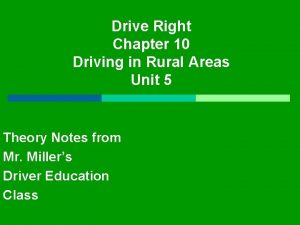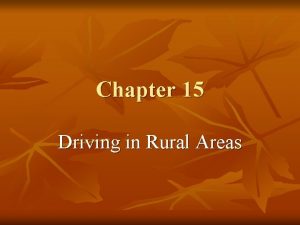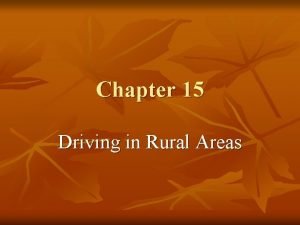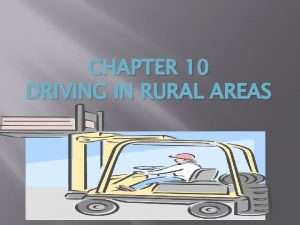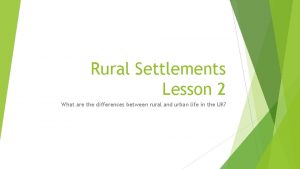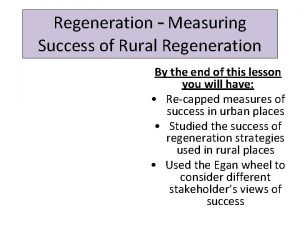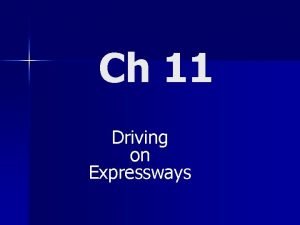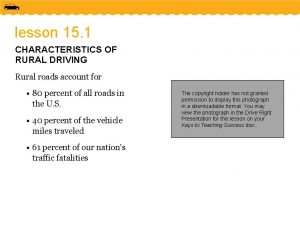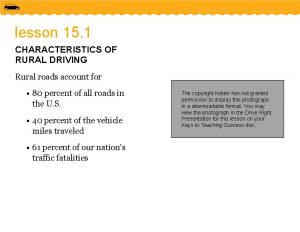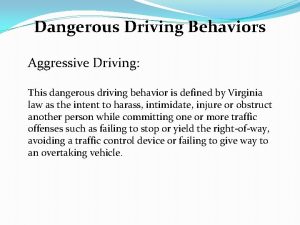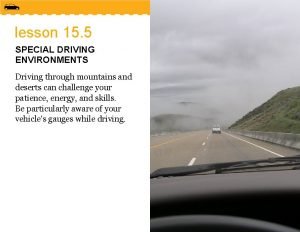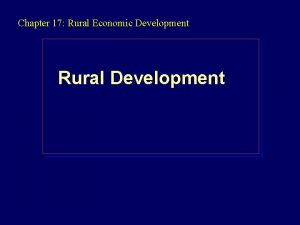lesson 15 1 CHARACTERISTICS OF RURAL DRIVING Rural
















- Slides: 16

lesson 15. 1 CHARACTERISTICS OF RURAL DRIVING Rural roads account for • 80 percent of all roads in the U. S. • 40 percent of the vehicle miles traveled • 61 percent of our nation’s traffic fatalities The copyright holder has not granted permission to display this photograph in a downloadable format. You may view the photograph in the Drive Right Presentation for this lesson on your Keys to Teaching Success disc.

OBJECTIVE Describe rural roadways.

Rural Roadways Rural roads can be paved or have a gravel surface. The shoulders can be wide or narrow. Road surfaces may be smooth or in very poor condition.

Lack of adequate lighting can make visibility difficult at night. Trees and other foliage can also restrict one’s line of sight on sunny days or during evenings, casting deceptive shadows.

OBJECTIVE Describe factors to consider when selecting a safe speed.

Safe Speed affects your line of sight, stopping distance, and vehicle control, and the amount of damage and injury suffered in the event of a collision.

There is a difference between safe speeds and posted speeds. Posted speeds are the maximum legal speeds allowed under ideal conditions. When conditions are not ideal, a slower speed is safer. Never drive faster than conditions allow.

Driveways, side roads, and entrances to fields may be difficult to identify. Did you see the vehicle waiting to pull out onto the road?

Identify traffic controls and how they OBJECTIVE help inform, warn, and regulate drivers on rural roads.

Traffic Controls Traffic controls are any signs, signals, and lane markings. They direct, regulate, inform, and warn drivers.

Most warning signs use graphics or pictures. Paying attention to warning signs will help you reduce your speed well in advance. Why do you think the warning sign is placed where it is?

Traffic controls can be complex, especially at intersections where rural highways cross.

OBJECTIVE List roadside hazards common in rural driving.

Roadside Hazards Rural roads may be narrow and not well maintained. Shoulders may be soft and uneven with the edge of the roadway. Deep ditches may be present just inches from the shoulder.

Trees, shrubs, or snow piles created by plows can restrict your line of sight. Be alert for drivers who could turn into your path of travel without warning.

lesson 15. 1 review 1. What factors should you use to help select a safe speed when driving on rural roads? 2. Why is it important for drivers to be aware of common rural roadside hazards?
 Chapter 10 driving in rural areas worksheet answers
Chapter 10 driving in rural areas worksheet answers Chapter 15 driving in rural areas
Chapter 15 driving in rural areas Rural areas have of development drivers ed
Rural areas have of development drivers ed Chapter 10 driving in rural areas
Chapter 10 driving in rural areas Define pra
Define pra Rural community definition characteristics
Rural community definition characteristics Characteristics of rural area
Characteristics of rural area Characteristics of rural area
Characteristics of rural area Characteristics of expressway driving
Characteristics of expressway driving Lesson outline lesson 3 describing circuits answers
Lesson outline lesson 3 describing circuits answers Lesson outline lesson 3 mountain building answers
Lesson outline lesson 3 mountain building answers Lesson outline lesson 2 aquatic ecosystems answer key
Lesson outline lesson 2 aquatic ecosystems answer key Micro lesson plan
Micro lesson plan L 101: introduction to health care leadership
L 101: introduction to health care leadership Mind map of gift of chappals
Mind map of gift of chappals What is an overall state of well-being or total health
What is an overall state of well-being or total health Lesson outline lesson 3 answer key
Lesson outline lesson 3 answer key
